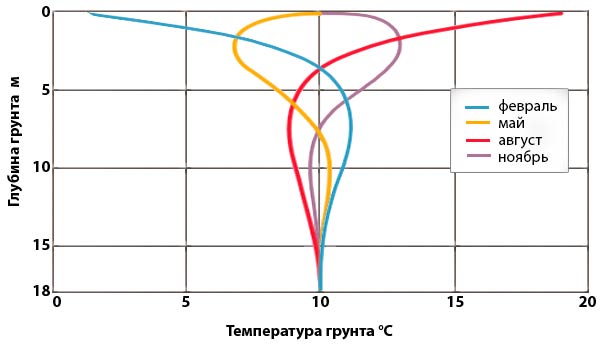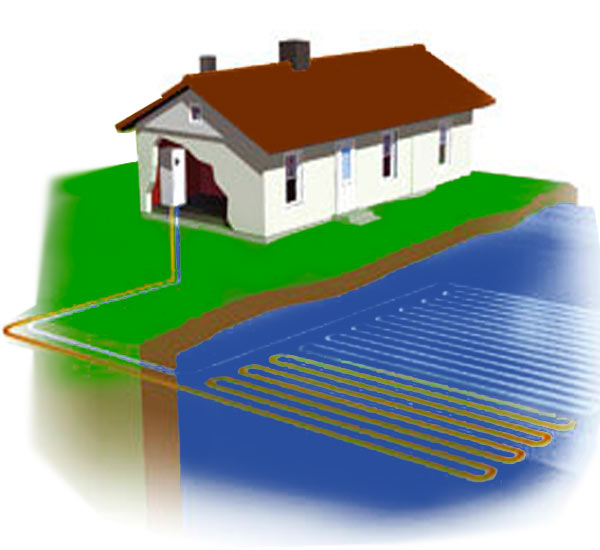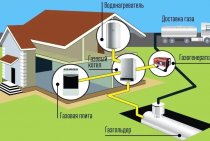Advantages and disadvantages
First of all, the advantages of heat pumps include efficiency: to transfer 1 kWh of thermal energy to the heating system, the installation needs to spend only 0.2-0.35 kWh of electricity. Since the conversion of thermal energy into electrical energy at large power plants occurs with an efficiency of up to 50%, the efficiency of fuel use when using heat pumps increases - trigeneration. Simplified requirements for ventilation systems and increases the level of fire safety. All systems operate using closed loops and require virtually no operating costs, other than the cost of electricity required to operate the equipment.
Another advantage of heat pumps is the ability to switch from heating mode in winter to air conditioning mode in summer: just instead of radiators, fan coils or “cold ceiling” systems are connected to an external collector.
The heat pump is reliable, its operation is controlled by automation. During operation, the system does not require special maintenance, possible manipulations do not require special skills and are described in the instructions.
An important feature of the system is its purely individual nature for each consumer, which consists in the optimal choice of a stable source of low-grade energy, calculation of the conversion coefficient, payback, and other things.
The heat pump is compact (its module does not exceed the size of a conventional refrigerator) and is almost silent.
Although the idea expressed by Lord Kelvin in 1852 was realized four years later, heat pumps were put into practice only in the 1930s. By 2012, in Japan, more than 3.5 million units are in operation, in Sweden, about 500,000 houses are heated by heat pumps of various types.
The disadvantages of geothermal heat pumps used for heating include the high cost of installed equipment, the need for complex and expensive installation of external underground or underwater heat exchange circuits. The disadvantage of air source heat pumps is the lower heat conversion efficiency associated with the low boiling point of the refrigerant in the external "air" evaporator. A common disadvantage of heat pumps is the relatively low temperature of the heated water, in most cases not more than +50 °C ÷ +60 °C, and the higher the temperature of the heated water, the lower the efficiency and reliability of the heat pump.
Thermal power plants what is it
Today, power stations are used for various purposes.
For example, special power plants that operate with the help of thermal energy are not the most used in this area, but they have a large number of operating advantages.
Such equipment generates, transmits and converts electricity, bringing it to the consumer.
Despite this functionality, the equipment requires careful diagnostics and maintenance. This includes standard technical safety practices, management organization and major maintenance work.
General view of the equipment
The design of the power plant is represented by a set of systems and key units that work to produce electricity by converting thermal energy into mechanical energy.
The main mechanism at such stations is a gross electric generator. In addition to the movable shaft, a combustion chamber is included in the design, from which heat is eventually released.
An important note is that this method involves the release of gaseous substances and steam.
Often this applies to stations that are fed through hydrological complexes. In such communications, the steam pressure rises, after which the steam moves the turbine rotor of the power plant.
Thus, all the energy enters the motor shaft and generates an electric current.
It is worth noting that not all thermal energy is lost in this case, but can be used, for example, for heating.
Principles of operation of thermal power plants
One of the main working moments is the voltage, due to which the station is powered. Often, complexes are equipped with an energy potential of up to a thousand volts. Basically, such stations are locally used to supply industrial facilities.
The second type includes complexes, the potential of which is over a thousand volts and is used to provide energy to individual areas, and sometimes cities. Their task is to transform and distribute energy.
An important factor is the power, which ranges from three to six GW. These figures depend on the type of fuel used for combustion in the combustion chamber. Today it is allowed to use diesel fuel, fuel oil, solid fuel and gas.
Construction of heating networks
To some extent, power plants are links in a huge heating network chain.
However, it is worth noting that, unlike similar networks using high-voltage lines, heat mains are used here.
They serve to provide hot water to stations.
Such lines imply the use of shut-off valves of suitable type and size, equipped with valves and methods for controlling the heat carrier.
In addition, in practice, the use of steam pipelines included in the infrastructure of thermal mains is used. However, in such cases, to ensure the correct operation of the plant, it is necessary to install condensate removal systems.
Automatic control systems
In the modern world, mechanical work is gradually being replaced by means of automation control. With the help of a special controller, the employee monitors the correct workflow of the station blocks, without being distracted from the functions of the dispatcher.
Thus, the operation of thermal blocks is controlled by special sensors, and the system records the data and transmits them to the control panel. After collecting information from sensors, the system analyzes and corrects the operating parameters of power plants.
Rules for the maintenance of power plants
The most important point in the excellent operation of the station is the maintenance of communications in proper condition.
Engineers test the performance of individual components of the installation, after which a comprehensive system diagnostics is carried out.
Specialists test the electronic and mechanical components of the case.
There are scheduled and periodic checks for defects, destruction and structural
At the same time, the work is not disturbed and the body materials are not deformed, which is important for the energy building.
After identifying and eliminating the centers of malfunctions, control is carried out by sensors and an analytical system under the supervision of the operator.
Results
The use of such systems implies the achievement of maximum productivity in the field of energy supply.
This is achieved by improving the skills of employees, improving and automating the work process, as well as installing modern equipment.
However, due to the high costs, the management tries to adhere to standard configurations and control methods in the management of power plants.
The main types of heat pumps are
water-water, air-air, soil-water, air-water, water-air, soil-air.
As you can see, natural sources of low-potential heat can come out - the heat of the soil, groundwater and outdoor air, and the directly circulating coolant in the system can be water (brine) as well as air.
soil as a heat source
The temperature of the soil from a depth of 5-6 meters is practically commensurate with the average annual temperature of the outside air. Due to the fact that the soil temperature is stable all 12 months of the year, the necessary temperature difference arises for the most productive operation of HP in winter - for heating, and in summer - for cooling. The required ground energy is taken by a ground collector located in the ground and accumulated in the coolant itself, then the coolant enters the HP evaporator and the circulation circle is repeated, after the next heat removal. An antifreeze liquid is used as such a coolant.
Usually, water is mixed with propylene glycol for use, it is also possible with ethylene glycol. Types of heat pumps "ground-to-water" or "ground-to-air" are divided into vertical and horizontal, depending on the location of the ground circuit in the ground. If the systems are made correctly, they are reliable and have a long service life. Also, the efficiency of vertical and horizontal HP remains high regardless of the time of year.
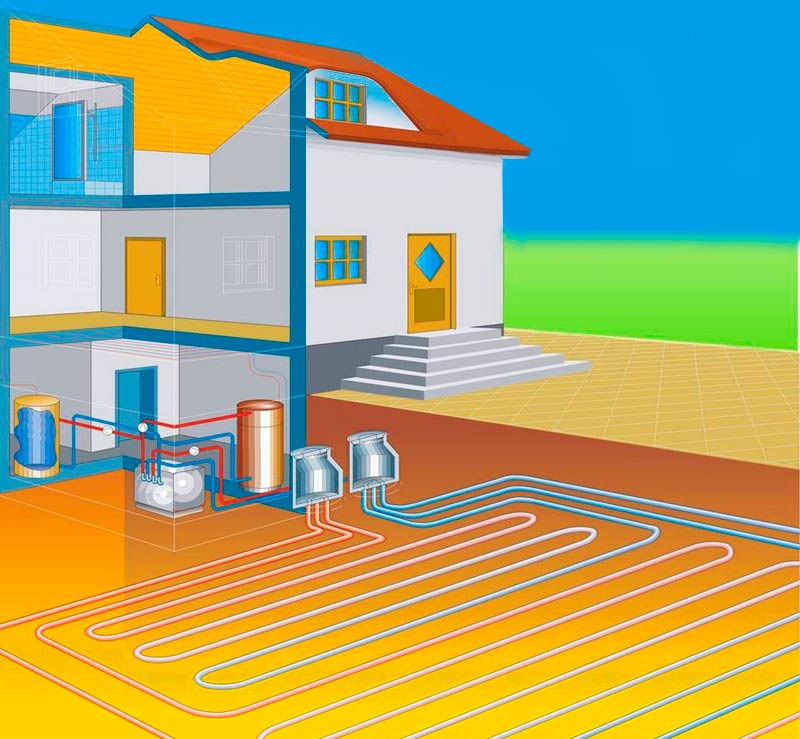 |
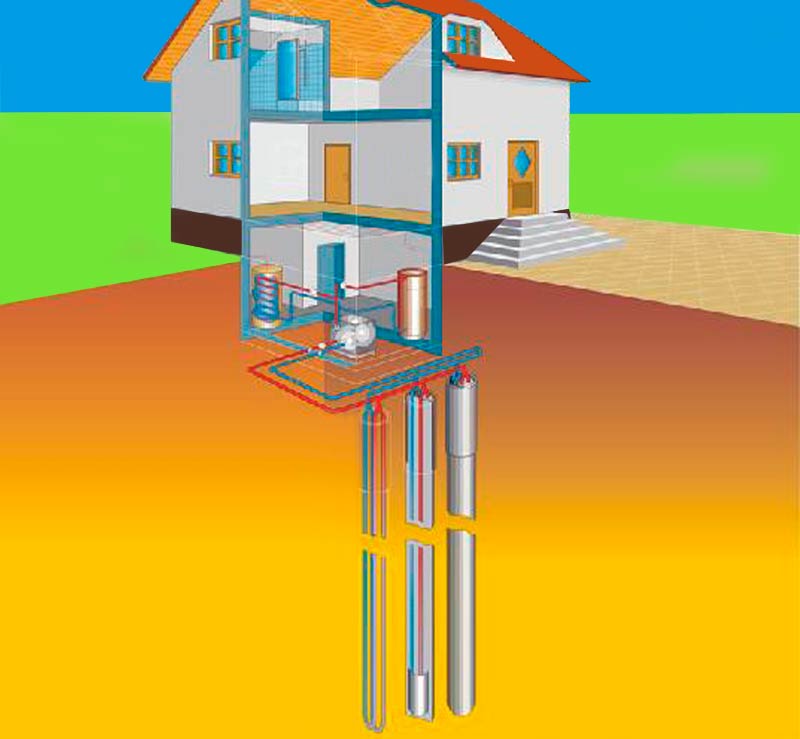 |
| Horizontal soil probe | Vertical ground probe |
Disadvantages of vertical ground probes:
- the need for a large technological area; - the occurrence of air sacs in the well due to unskilled laying, which significantly worsen heat removal from the ground; - the impossibility of reconstruction.
Disadvantages of horizontal ground probes:
- require high operating costs; - the impossibility of using passive cooling; - volumetric earthworks; - the technical feasibility of installation of structures is limited by additional requirements.
Water as a heat source
The use of this type of heat is quite diverse. HP "water-water" and "water-air" allow the use of groundwater, such as artesian, thermal, groundwater. It is also widely used as a heat source - reservoirs, lakes, wastewater, etc. The lower the pipe is located in the water column, through which heat is transferred, the more stable, reliable and productive the operation of the HP.
Advantages of heat pumps water-water, water-air:
- excellent COP conversion coefficient due to stable source temperature (groundwater temperature is around 6-7 °C all year round); - systems occupy small technological areas; - service life of 30-40 years; - minimum operating costs; - possibility of application large capacities.
Disadvantages of heat pumps water-water, water-air:
- applicable is limited by territoriality, due to the lack of a source or in urban conditions; - high requirements for the debit of the supply well are needed; - when the water temperature rises, it is necessary to check the anti-corrosion protection and the content of manganese and iron.
Air as a heat source
HP air-to-water or air-to-air are most often used for bivalent or monoenergetic heating systems, and providing hot water.
Advantages of air-to-air and air-to-water heat pumps:
- simplicity of design, installation and operation; - the possibility of using in any climatic zone; - the lowest cost and payback period compared to HP of other heat sources;
Disadvantages of heat pumps (HP) "air-to-air", "air-to-water":
- deterioration of the efficiency coefficient due to changes in the ambient temperature; - low system performance at temperatures below 0 ° C, which implies the need for an additional heat source for the heating period.
Heat engines of external combustion
- one.A Stirling engine is a thermal apparatus in which a gaseous or liquid working fluid moves in a closed space. This device is based on periodic cooling and heating of the working fluid. In this case, energy is extracted, which occurs when the volume of the working fluid changes. The Stirling engine can run on any heat source.
- 2. Steam engines. Their main advantage is simplicity and excellent traction qualities, which are not affected by the speed of work. In this case, you can do without a gearbox. In this way, the steam engine differs for the better from the internal combustion engine, which produces an insufficient amount of power at low speeds. For this reason, the steam engine is convenient to use as a traction engine. Disadvantages: low efficiency, low speed, constant water and fuel consumption, high weight. Previously, steam engines were the only engine. But they required a lot of fuel and froze in winter. Then they were gradually replaced by electric motors, internal combustion engines, steam turbines and gas, which are compact, higher efficiency, versatility and efficiency.
Acceptance of thermal installations from repair
When accepting equipment from repairs, an assessment of the quality of the repair is carried out, which includes an assessment of: the quality of the repaired equipment; the quality of the repairs carried out.
Quality ratings are set:
- preliminary - upon completion of testing of individual elements of a thermal power plant and as a whole;
- finally - based on the results of a monthly controlled operation, during which the equipment should be tested in all modes, tests and adjustment of all systems should be carried out.
Works performed during the overhaul of thermal power plants are accepted according to the act. The acceptance certificate is accompanied by all technical documentation for the repair performed (sketches, intermediate acceptance certificates for individual units and intermediate test reports, as-built documentation, etc.).
Repair acceptance certificates with all documents are stored permanently together with the technical data sheets of the installations. All changes identified and made during the repair are entered into the technical data sheets of the installations, diagrams and drawings.
Story
The concept of heat pumps was developed back in 1852 by the outstanding British physicist and engineer William Thomson (Lord Kelvin) and further improved and detailed by the Austrian engineer Peter Ritter von Rittinger. Peter Ritter von Rittinger is considered the inventor of the heat pump, having designed and installed the first known heat pump in 1855. But the practical application of the heat pump acquired much later, or rather in the 40s of the XX century, when the inventor-enthusiast Robert Weber (Robert C Webber) experimented with the freezer. One day, Weber accidentally touched a hot pipe at the exit of the chamber and realized that the heat was simply thrown out. The inventor thought about how to use this heat, and decided to put a pipe in a boiler to heat water. As a result, Weber provided his family with an amount of hot water that they could not physically use, while some of the heat from the heated water was released into the air. This prompted him to think that both water and air can be heated from one heat source at the same time, so Weber improved his invention and began to drive hot water in a spiral (through a coil) and use a small fan to distribute heat around the house in order to heat it. Over time, it was Weber who had the idea to “pump out” heat from the earth, where the temperature did not change much during the year. He placed copper pipes in the ground, through which freon circulated, which "collected" the heat of the earth.The gas condensed, gave up its heat in the house, and again passed through the coil to pick up the next portion of heat. The air was set in motion by a fan and circulated throughout the house. The following year, Weber sold his old coal stove.
In the 1940s, the heat pump was known for its extreme efficiency, but the real need for it arose after the oil crisis in 1973, when, despite low energy prices, there was an interest in energy conservation.
Captions for slides
slide 1
Presentation Types of heat engines Completed by: student of group 14K1 Polina Kozhenova
slide 2
Heat engines Steam engine Gas, steam turbine Jet engine ICE Types of heat engines
slide 3
Heat engines realize in their work the transformation of one type of energy into another. Thus, machines are devices that serve to convert one type of energy into another. Convert internal energy into mechanical energy. The internal energy of heat engines is formed due to the energy of the fuel
slide 4
A steam engine is an external combustion heat engine that converts the energy of heated steam into mechanical work of the reciprocating movement of the piston, and then into the rotational movement of the shaft. In a broader sense, a steam engine is an external combustion engine that converts steam energy into mechanical work.
slide 5
An internal combustion engine is a type of engine, a heat engine, in which the chemical energy of the fuel that burns in the working area is converted into mechanical work. Despite the fact that internal combustion engines are a relatively imperfect type of heat engines, they are very widespread, for example, in transport. Despite the fact that internal combustion engines are a relatively imperfect type of heat engines, they are very widespread, for example, in transport.
slide 6
A gas turbine is a continuous heat engine, in the blade apparatus of which the energy of compressed and heated gas is converted into mechanical work on the shaft. It consists of a compressor connected directly to the turbine, and a combustion chamber between them.
Slide 7
A steam turbine is a continuous heat engine, in the blade apparatus of which the potential energy of compressed and heated water vapor is converted into kinetic energy, which in turn performs mechanical work on the shaft.
Slide 8
The jet engine creates the traction force necessary for movement by converting the initial energy into the kinetic energy of the jet stream of the working fluid. The working fluid flows out of the engine at high speed, and in accordance with the law of conservation of momentum, a reactive force is formed that pushes the engine in the opposite direction.
Slide 9
The variety of types of heat engines indicates only the difference in the design and principles of energy conversion. Common to all heat engines is that they initially increase their internal energy due to the combustion of fuel, followed by the conversion of internal energy into mechanical energy.
Definition of a heat pump
A heat pump (HP) is one of the thermotransformer devices that provide heat from one body to another, which have different temperatures. Thermal transformers can be step-up if they are designed to transfer heat to bodies with a low temperature, and step-down if they are used to transfer heat to bodies with a high temperature.
For a long time, the heat pump remained a thermodynamic mystery, although the principle of its operation follows from the works of Carnot, in particular, the description of the Carnot cycle, published in his dissertation as early as 1824. A practical heat pump system, called a heat multiplier, was proposed in 1852 by Lord Kelvin, who showed how can be effectively used for heating purposes.
The heat pump transfers internal energy from an energy carrier with a low temperature to an energy carrier with a higher temperature. Since, in accordance with the second law of thermodynamics, heat energy can only pass from a high temperature level to a low one without any external influence, it is necessary to use drive energy to implement the heat pump cycle. Therefore, the process of energy transfer in the direction opposite to the natural temperature difference is carried out in a circular cycle.
The main purpose of these installations is to use the heat of a low-potential source, such as the environment. For the implementation of the heat pump process, the necessary consumption of external energy of any kind: mechanical, chemical, kinetic, electrical, etc.
There are currently three types of heat pumps that are mainly used:
• compression for heat supply of individual houses, as well as for heat supply of individual industrial workshops or installations;
• absorption for heat supply of buildings and industrial shops;
• thermoelectric for heating individual premises or small houses.
The energy carriers supplied with thermal energy at low temperature for the implementation of the heat pump cycle are called sources warmth. They release thermal energy by heat transfer, convection and/or radiation. Energy carriers that perceive thermal energy of increased potential in the heat pump cycle are called receivers heat. They perceive thermal energy by heat transfer, convection and (or) radiation.
In general, the following definition can be proposed: a heat pump is a device that perceives the heat flow at a low temperature (on the cold side), as well as the energy necessary to drive and both energy flows at an elevated (compared to the cold side) temperature in the form of a heat flow.
This definition is valid for compression heat pumps as well as absorption and thermoelectric units using the Peltier effect.
Heating capacity (thermal power) of a vapor compression HP consists of two components: the heat received by the vaporizer from a heat source (the so-called cooling capacity and drive power R, by means of which the input thermal energy is raised to a higher temperature level.
In the absorption HP, the mechanical compressor was replaced by a thermochemical one, in the form of an additional solution circulation circuit with a generator (boiler) and an absorber. Instead of electrical drive energy supplied to the electrically driven compression heat pump, thermal energy is supplied to the generator. However, for both processes, an energy source in the form of waste heat or environmental energy is used with the help of an evaporator.
Usually in the process of environmental energy conversion is the final stage of the process. The energy released during the combustion of solid fuel or in nuclear reactors undergoes a large number of transformations until it takes the form necessary for consumers, is fully used, and, finally, almost always passes into the environment. Heat pumps require a completely different theoretical approach. Here, at the beginning of the process, environmental energy is also used as a heat source in addition to the drive energy.
Types of repairs of body installations.
The main types of repairs of thermal power plants and heating networks are capital and current. The scope of maintenance and repair is determined by the need to maintain a serviceable, operable condition and periodic restoration of thermal power plants, taking into account their actual technological state.
Overhaul is a repair performed to restore the technical and economic characteristics of an object to values close to the design values, with the replacement or restoration of any components.
Acceptance of thermal power plants from overhaul is carried out by a working commission appointed by the administrative document for the organization.
Annual renovation plan. For all types of thermal power plants, it is necessary to draw up annual (seasonal and monthly) repair schedules. Annual repair plans are approved by the head of the organization. The plans provide for the calculation of the complexity of the repair, its duration (downtime in repairs), the need for personnel, as well as for materials, components and spare parts, and their consumable and emergency stock is created.
The current repair of thermal installations is a repair performed to maintain the technical and economic characteristics of an object within the specified limits with the replacement and / or restoration of individual wear parts and parts. Acceptance from the current repair is carried out by persons responsible for the repair, good condition and safe operation of thermal power plants.
The frequency and duration of all types of repairs are established by regulatory and technical documents for the repair of this type of thermal power plants.
